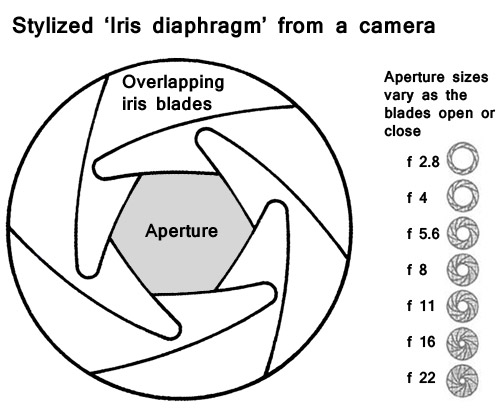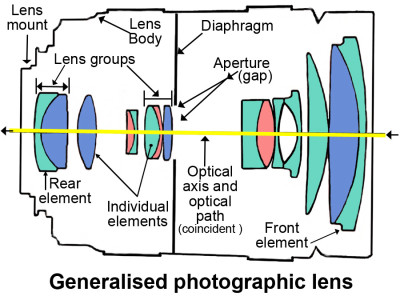![]()
Diaphragm; Iris Diaphragm; Iris

An 'Iris Diaphragm' as used in modern DSLR cameras.
The iris diaphragm may have a fixed size aperture. In modern DSLRs the diaphragm normally mounts a mechanism to control an Iris. The iris is a set of overlapping blades in a fan-like arrangement around the aperture. As the blades slide sideways across each other the aperture can open or close allowing more or less light through.

Click image to view large
Generalised photographic lens layout showing showing the principle features.
The set of overlapping blades forming the aperture (not shown in the generalised diagram) are called an iris. The arrangement of the blades in the iris, and the aperture at its middle, perform the same function as the iris in the human eye, itself surrounding the pupil. Light enters the eye through the ‘pupil’ (eye ‘aperture’).
The diaphragm and the iris are NOT the same thing. However, they are intimately linked in the construction of modern cameras. As such the entire mechanism has become known as the ‘iris diaphragm’. sometimes known just as ‘iris’. This picture on Wikipedia shows that the diaphragm can be a complex mechanism ![]() for controlling the iris and aperture.
for controlling the iris and aperture.
It is often said that the aperture is a circular hole. However, the iris diaphragm does not make a perfect circular hole. The blades are curved in order to make the aperture as circular as possible. Unfortunately they would not ever form a perfect circle. In higher quality lenses, more blades make the hole more circular. The shape of the aperture affects the shape of bokeh in the highlights of photographs.
In some point-and-shoot cameras there is no proper diaphragm or iris. In these cases an automatic ‘ND filter’ is used to control the amount of light that comes through the lens.
In previous times different types of diaphragm were used. In most cases the diaphragm itself was a thin metal disc with a hole in the centre (aperture). The diaphragm had a another rotating disc mounted on it which had different sized holes. One of these could be lined up with the aperture to regulate the light allowed through. This ‘rotating diaphragm’ allowed the simple manual adjustment of the aperture. Rotating Diaphragm picture ![]() . Other ways to achieve a similar aperture size-control have been used in the history of photography.
. Other ways to achieve a similar aperture size-control have been used in the history of photography.
Photographic Glossary – Definitions, articles and resources…
Definition: Aperture
The diaphragm can be a complex mechanism
Definition: Bokeh
Rotating Diaphragm picture
